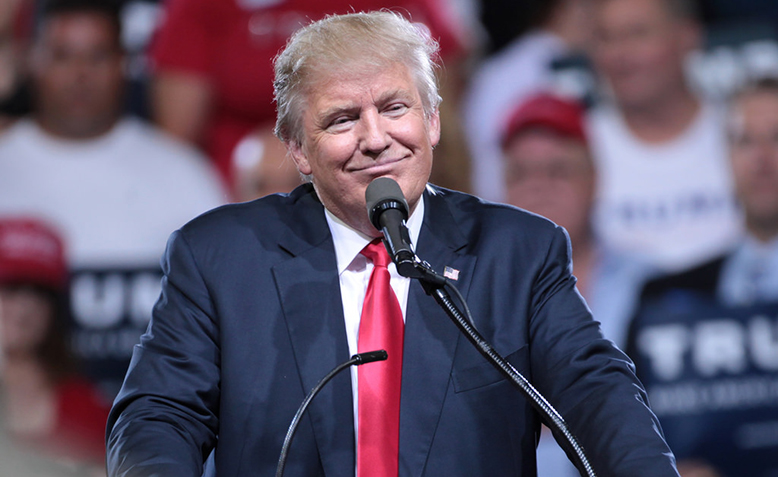 US President Donald Trump. Photo: Flickr/ Gage Skidmore
US President Donald Trump. Photo: Flickr/ Gage Skidmore
How did America elect its most reactionary President ever, asks John Rees
Let’s not waste any more time than is absolutely necessary describing Donald Trump. The 45th President of the United States is a reactionary populist, a racist and a misogynist. This we know. The important question is why did it happen? Let’s look at the causes:
1 Hillary Clinton. This was Clinton’s election to lose and she lost it. Faced with an insurgent, anti-establishment populist, the Democrats ran the candidate most likely to build the Trump vote. The millionaire, ultra-establishment figure from a dynastic Presidential family must have been the opponent that Trump had dreamed of running against. But we can put the same point another way: Bernie Sanders could have, and if the polling is right, would have beaten Trump. To beat a fake anti-establishment populist right winger would have taken a genuine left-wing anti-establishment figure who, let’s not forget this, made the term socialist popular among hundreds of thousands of Americans.
2 Barack Obama. This election is the only assessment of the Obama presidency that matters and it reads: ‘you didn’t do enough’. Obama’s White House was the nearest that real life was ever going to get to the West Wing dream of a liberal presidency. But just not being George Bush was not enough. A weak healthcare system, the best of the Obama presidency, was not enough to make millions of Americans feel that enough was being done to repair the generation long disaster of neoliberal economics. Just not repeating Iraq, especially when Libya was a disaster that played so well for Trump, didn’t look like the War on Terror was over.
3 The Republicans. From Sarah Palin and the Tea Party to the semi-automatic machine-gun-toting militias, the Republicans have fed the extreme right during the Obama presidency. They fed the racism towards America’s first black president. The fed the gun culture. The Republican establishment turned against Trump at the last moment, but he is very surely their monster.
4 The political system. Noam Chomsky famously described US politics as a totalitarian system with two different factions. The myth is that ‘any boy can become President’. The truth is that only millionaire boys with millionaire backers can become President. Much more than in Britain, it’s evident that whoever you vote for you get the same free market economics at home and the same imperial wars abroad. Trump is an illusory alternative to all that, a mere rhetorical pose of an alternative. But in the arid desert of US political debate that was enough… for now.
5 It’s the economy, stupid. Clinton lost this election in the rust belt states. When Trump said ‘it used to be that they made cars in Flint and you couldn’t drink the water in Mexico, but now they make cars in Mexico and you can’t drink the water in Flint’, it resonated. Big time. This is an economy in which for the last 40 years all gains in household income have gone to the top 20 percent of households. For the last 20 years, dividends and capital gains have grown faster than wages, and that’s after tax. Real wages have declined so far that it takes two wages to provide the same standard of living as one wage provided in the 1970s. Meanwhile productivity is soaring. People are working harder and longer for less. No wonder nostalgia for an imaginary past where ‘America was great’ appeals to them.

What next?
The threats are obvious. Trump could turn his support base into an active and organised reactionary popular movement that smashes up black and migrant communities, the labour movement and the left. But he has difficulties in moving down this path.
Firstly, he is a maverick member of the establishment he pretends to hate so much. And, like every US President, the structural establishment control over his office will be considerable. The Fed, the CIA, the NSA, the Pentagon, corporate power and many other institutions will determine policy. An establishment figure like Clinton would have had her own power bases and resources within these institutions. Trump is a maverick who does not have these resources to the same degree and may be more malleable, as well as less predictable, for that reason. The US ruling class have a President they don’t want, and that will make politics unstable but not necessarily easy for Trump.
Secondly, the American working class has got a President that half of them detest and who cannot deliver for the other half that put their faith in him. This will add to the instability as Trump tries to survive the hostility of considerable sections of both major classes. He can do it of course. Some in the ruling class will seize on a Trump presidency to hurry on with their own projects of increased exploitation at home and further war abroad. But there will also be opportunities for resistance in a system now widely understood to be fundamentally broken.
The Black Lives Matter movement has produced a level of resistance not seen since the 1960s in black communities. Trump’s visceral attacks on Latin Americans has politicised that community. Bernie Sanders, only a few months ago, was pulling rallies far exceeding the scale of Trump events. Sanders made socialism a usable ideology for the left on a scale unseen since the 1960s. A non-sectarian left can use these points of resistance in a crisis-ridden political system to redirect the wave of anger at the real enemies of the US working class.

